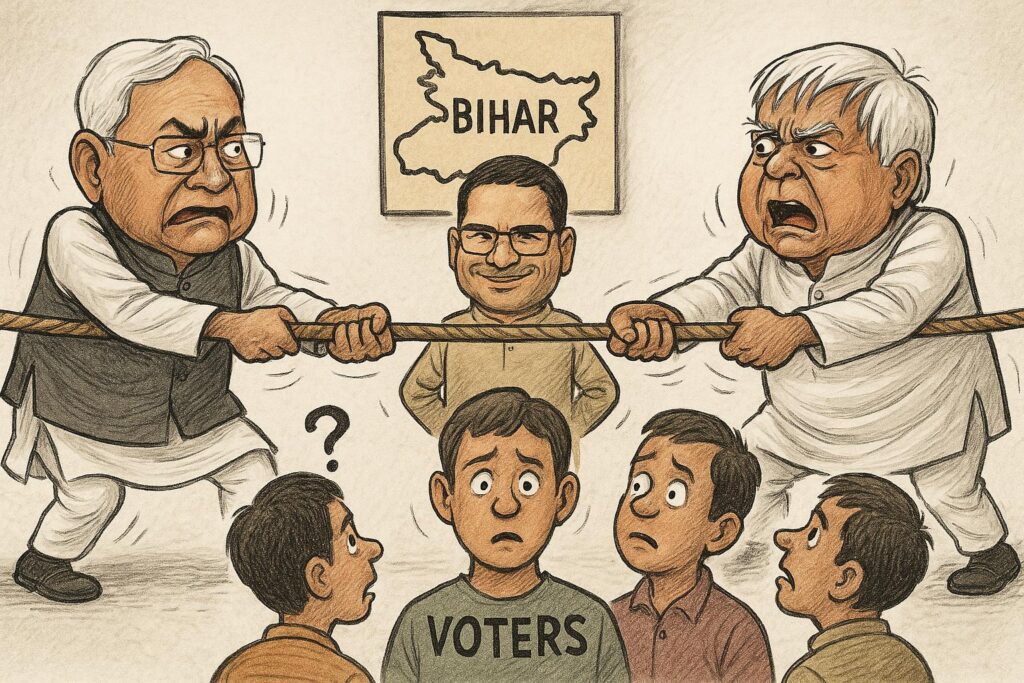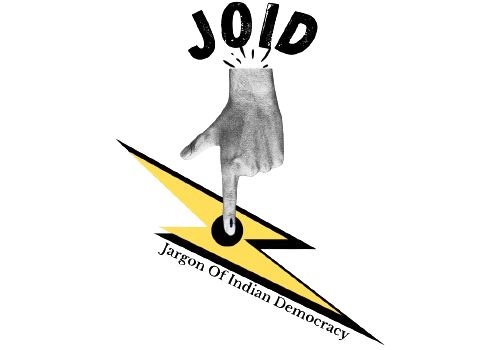
In Bihar’s tense political environment since yesterday’s PK rally, it’s easy to get caught up in the trolling, comparisons, and crowd numbers. However, if RJD and JD(U) focus on mocking PK instead of addressing their own issues, they might be missing the bigger picture. The bigger question is: Where do RJD and JDU stand today in terms of narrative, trust, and voter confidence? And more importantly, why are both parties still unable to decisively expand beyond their traditional caste bases?
RJD: Still Chained to the Jungle Raj Tag: RJD has undoubtedly built a loyal base of Muslims and Yadavs (MY), making it the single-largest party in the 2020 Bihar Assembly elections. Tejashwi Yadav’s campaign energy, crowd-pulling ability, and social media appeal are noteworthy. But the truth remains: outside the MY belt, RJD is still struggling for legitimacy. Despite nearly 15 years out of power, the ‘Jungle Raj’ image hasn’t faded. Hard Numbers Tell a Harder Truth: Between 1992–2004, under Lalu Yadav’s rule, kidnapping for ransom in Bihar increased by over 400%, with professionals like doctors, teachers, and traders being regularly targeted, and the state ranked among the worst for law and order (NCRB). When Nitish Kumar came to power in 2005, even if development was slow, law and order improved significantly: To date, non-MY castes—EBCs, Mahadalits, upper castes, still do not associate RJD with the lawless past, and the party has done little to reset that narrative.
2020 Assembly elections: Numbers That Hide Limitations
● RJD: 75 MLAs – emerged as the single largest party.
● But couldn’t form a government. NDA with 125 MLAs did.
● The victory margin in many seats was thin, often due to LJP cutting into JD(U) votes.
Key Insight: The hype and numbers wasn’t purely due to Tejashwi. It was a combination of:
● Anti-incumbency against Nitish Kumar,
● LJP’s spoiler role, and
● Lack of viable alternatives for youth in rural areas.
Remove those external factors, and RJD’s performance may not hold up if it goes with the same alliance and the same attitude in 2025. As one local journalist from Darbhanga aptly said: “If an EBC or upper caste votes for an RJD candidate, it’s for the individual—not the party. The Jungle Raj stigma hasn’t gone away.” Even Tejashwi’s most electrifying rallies fail to convert into trust among first-time voters and women, particularly in semi-urban and upper-caste-dominated belts.
The Real Problem: No Narrative Reset
“Tejashwi pulls the crowd—but governance promises are missing. No clear roadmap, no serious law & order vision, and district units are still led by Lalu-era loyalists.” This critique isn’t just Hawabazi, it’s visible on the ground. From Nalanda to Vaishali, from Buxar to Bhabua, voters still associate RJD with fear, not future. A party that hasn’t publicly distanced itself from its past, or committed to modern governance standards, will keep facing resistance outside its comfort zone.
JDU: The Shrinking Centre
On the other side is JD(U), once the anchor of Bihar’s regional coalition politics, now struggling with identity fatigue. Nitish Kumar’s frequent political flip-flops—allying with BJP, then RJD, then BJP again—have damaged his image as a steady leader. Youth voters, who once saw him as a quiet performer, now see a leader clinging to relevance. JD(U)’s organizational structure has hollowed out in many districts, and with Nitish aging and lacking a clear successor, the party’s future looks unstable.
Nitish’s old USP—governance is now expected from every serious party. And he hasn’t been able to create a strong, emotionally resonant narrative like RJD’s social justice plank or BJP’s nationalism.
PK’s Rally: A Flop in Optics, But a Signal You Can’t Ignore
Yes, Prashant Kishor’s April 11 rally at Gandhi Maidan didn’t match the hype, 2 lakhs plus chairs, only 50k–1 lakh people, and visible mismanagement. By PK’s own high bar, it was a letdown.
But here’s the catch: the crowd was really not driven by any one caste or religion. PK attracts aspirational, first-time voters who usually don’t attend political rallies.
The established parties mocking PK are repeating the same mistake Congress made with Kejriwal. Jan Suraaj may not have sparked a wave, but the undercurrent is real. If PK builds on this momentum with ground-level work, he’s not Pushpam Priya, he’s a long-term threat.
Gandhi Maidan wasn’t a victory but it was a warning shot. Ignore it at your own risk.
Conclusion: Reflect, Don’t Deflect
Bihar’s political mood in 2025 will be very different from 2020. The anti-incumbency against Nitish is now layered with disappointment with RJD and fatigue with old faces.
If RJD wants to expand beyond its vocal MY base, it must acknowledge its past, shift its narrative towards security, women’s empowerment, job creation, and clean governance, while bringing in fresh faces and professionalizing the party structure. If JD(U) wants to remain relevant, it must JD(U) must stop being a “swing” party, redefine its core identity, invest in second-line leadership, and reconnect with EBC and women voters it once had. And if both want to win more than just caste comfort zones, they need to introspect harder than they troll.

Ravi Kumar is a political consultant and Socio-Political Writer. He comments on different contemporary political issues and writes about it as he has sound experience due to his prolonged work on the ground as persistent observer of the Democracy on field.
